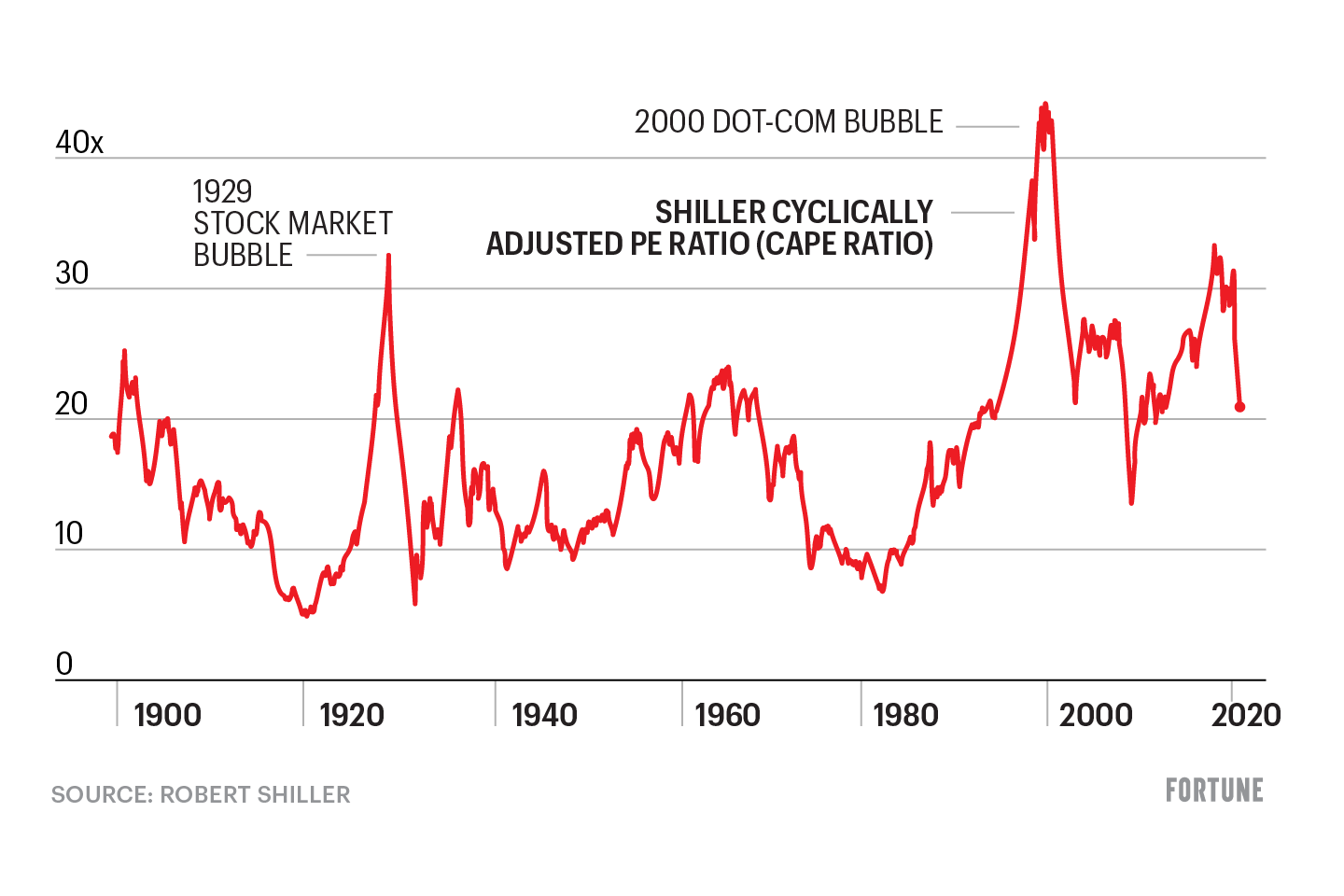我一直在想這種事是否真有可能發(fā)生。席勒周期調(diào)整市盈率(P/E)在七年多內(nèi)首次達(dá)到了長期平均水平。這可能是一個信號,意味著在新型冠狀病毒引發(fā)股市暴跌之后,現(xiàn)在的市場整體上是買進(jìn)的好時機。
這可能是一個重要的里程碑,因為諾貝爾獎得主和耶魯大學(xué)教授羅伯特·席勒提供了一種最好的指標(biāo),可用來衡量股價過低、過高還是處在合理區(qū)間內(nèi)。這個著名的指標(biāo)名為周期調(diào)整市盈率,簡稱CAPE。CAPE指標(biāo)的優(yōu)點在于,它不同于標(biāo)準(zhǔn)市盈率,并不依賴過去四個季度報告的最近年化收益數(shù)據(jù)。以本期利潤為分母很容易產(chǎn)生誤導(dǎo),因為按照標(biāo)準(zhǔn)市盈率公式計算,在盈利衰退期會夸大市盈率,但實際上股票價格很低;當(dāng)利潤達(dá)到不可持續(xù)的極高水平時,又會低估股票的實際價值。

席勒的指標(biāo)計算的是過去10年的平均通脹調(diào)整后收益。這種計算方式排除了突然出現(xiàn)的波動,因此能更準(zhǔn)確地體現(xiàn)股票的價值,因為如果根據(jù)本期收益計算,這種突然波動會使市盈率數(shù)據(jù)失真。
最近一段時間,企業(yè)利潤出現(xiàn)了不可持續(xù)的泡沫,使股票看起來雖然價格較高但沒有高到離譜,而實際上已經(jīng)非常昂貴。我們會看到,CAPE指標(biāo)就不會出現(xiàn)這樣的錯誤。
過去50年,CAPE的中位數(shù)倍數(shù)是20.3倍。根據(jù)席勒提出的107美元的每股調(diào)整后收益,標(biāo)普指數(shù)在2172點才算達(dá)到其長期正常估值水平(107美元每股收益乘以20.3)。長期正常估值可以作為CAPE的關(guān)鍵基準(zhǔn)。3月23日星期一,標(biāo)普指數(shù)收于2237點,與2172點只相差不到3%,在中午交易時段一度相差不到1%。值得注意的是,在特朗普當(dāng)選的2016年11月8日,標(biāo)普指數(shù)收盤時的水平,比今天所謂的公允價值高出1.5%。
當(dāng)CAPE超過25倍的時候,即比半個世紀(jì)的中位數(shù)高約20%,通常會發(fā)生兩件事,這或許能給我們帶來啟發(fā)。首先,在未來的某個時間點,CAPE通常都會回落到20倍以下;其次,回落的過程非常漫長。例如,1966年1月,CAPE接近25倍,在1969年年中之前一直維持在20至25倍之間。
后來,CAPE下降到十幾倍甚至個位數(shù),直到1995年才恢復(fù)到25倍。之后,CAPE一直高于該水平,直到2008年金融危機爆發(fā),CAPE倍數(shù)大幅下降。2014年8月,CAPE重新恢復(fù)到25倍,在今年年初以前一直維持在25至35倍之間的高點。2月底的CAPE為30.8倍,比20.3倍的歷史平均值高出52%。
新型冠狀病毒疫情使CAPE出現(xiàn)了史上速度最快、幅度最大的下滑,在3月23日回落到50年基準(zhǔn)水平。根據(jù)CAPE衡量,投資者拋售股票使市場進(jìn)入了所謂的“正常”水平,這對于認(rèn)為當(dāng)前股票價格被嚴(yán)重低估的觀點提出了質(zhì)疑。沒有人知道CAPE倍數(shù)從較高點回落到20.3倍需要多長時間,但這一天終究會到來。或許,這次歷史性的暴跌只是讓股市回歸到它一直以來應(yīng)有的水平:公允價值。(財富中文網(wǎng))
翻譯:劉進(jìn)龍
審校:汪皓
我一直在想這種事是否真有可能發(fā)生。席勒周期調(diào)整市盈率(P/E)在七年多內(nèi)首次達(dá)到了長期平均水平。這可能是一個信號,意味著在新型冠狀病毒引發(fā)股市暴跌之后,現(xiàn)在的市場整體上是買進(jìn)的好時機。
這可能是一個重要的里程碑,因為諾貝爾獎得主和耶魯大學(xué)教授羅伯特·席勒提供了一種最好的指標(biāo),可用來衡量股價過低、過高還是處在合理區(qū)間內(nèi)。這個著名的指標(biāo)名為周期調(diào)整市盈率,簡稱CAPE。CAPE指標(biāo)的優(yōu)點在于,它不同于標(biāo)準(zhǔn)市盈率,并不依賴過去四個季度報告的最近年化收益數(shù)據(jù)。以本期利潤為分母很容易產(chǎn)生誤導(dǎo),因為按照標(biāo)準(zhǔn)市盈率公式計算,在盈利衰退期會夸大市盈率,但實際上股票價格很低;當(dāng)利潤達(dá)到不可持續(xù)的極高水平時,又會低估股票的實際價值。
席勒的指標(biāo)計算的是過去10年的平均通脹調(diào)整后收益。這種計算方式排除了突然出現(xiàn)的波動,因此能更準(zhǔn)確地體現(xiàn)股票的價值,因為如果根據(jù)本期收益計算,這種突然波動會使市盈率數(shù)據(jù)失真。
最近一段時間,企業(yè)利潤出現(xiàn)了不可持續(xù)的泡沫,使股票看起來雖然價格較高但沒有高到離譜,而實際上已經(jīng)非常昂貴。我們會看到,CAPE指標(biāo)就不會出現(xiàn)這樣的錯誤。
過去50年,CAPE的中位數(shù)倍數(shù)是20.3倍。根據(jù)席勒提出的107美元的每股調(diào)整后收益,標(biāo)普指數(shù)在2172點才算達(dá)到其長期正常估值水平(107美元每股收益乘以20.3)。長期正常估值可以作為CAPE的關(guān)鍵基準(zhǔn)。3月23日星期一,標(biāo)普指數(shù)收于2237點,與2172點只相差不到3%,在中午交易時段一度相差不到1%。值得注意的是,在特朗普當(dāng)選的2016年11月8日,標(biāo)普指數(shù)收盤時的水平,比今天所謂的公允價值高出1.5%。
當(dāng)CAPE超過25倍的時候,即比半個世紀(jì)的中位數(shù)高約20%,通常會發(fā)生兩件事,這或許能給我們帶來啟發(fā)。首先,在未來的某個時間點,CAPE通常都會回落到20倍以下;其次,回落的過程非常漫長。例如,1966年1月,CAPE接近25倍,在1969年年中之前一直維持在20至25倍之間。
后來,CAPE下降到十幾倍甚至個位數(shù),直到1995年才恢復(fù)到25倍。之后,CAPE一直高于該水平,直到2008年金融危機爆發(fā),CAPE倍數(shù)大幅下降。2014年8月,CAPE重新恢復(fù)到25倍,在今年年初以前一直維持在25至35倍之間的高點。2月底的CAPE為30.8倍,比20.3倍的歷史平均值高出52%。
新型冠狀病毒疫情使CAPE出現(xiàn)了史上速度最快、幅度最大的下滑,在3月23日回落到50年基準(zhǔn)水平。根據(jù)CAPE衡量,投資者拋售股票使市場進(jìn)入了所謂的“正常”水平,這對于認(rèn)為當(dāng)前股票價格被嚴(yán)重低估的觀點提出了質(zhì)疑。沒有人知道CAPE倍數(shù)從較高點回落到20.3倍需要多長時間,但這一天終究會到來。或許,這次歷史性的暴跌只是讓股市回歸到它一直以來應(yīng)有的水平:公允價值。(財富中文網(wǎng))
翻譯:劉進(jìn)龍
審校:汪皓
I’ve been wondering if it would actually happen. For the first time in more than seven years, the Shiller price/earnings ratio, or P/E, is flirting with its long-term average. This could be a signal that, at long last, the overall market—in its coronavirus-driven collapse––is now a good buy.
This event could prove a landmark, because Robert Shiller, the Nobel Prize winner and Yale professor, offers what’s arguably the best yardstick for measuring whether stocks are cheap, expensive, or sit somewhere in the reasonable range. Shiller calls his famed metric the CAPE, for cyclically adjusted price/earnings ratio. The CAPE’s beauty is that unlike the standard P/E, it doesn’t rely on the most recent annualized earnings numbers reported over the past four quarters. Using current profits as the denominator is highly misleading, because that formula inflates the P/E in an earnings recession, when stocks are actually bargains, and understates how rich they really are when profits hit unsustainable lofty levels.
Instead, Shiller calculates an average of inflation-adjusted earnings over the past 10 years. That provides a truer reading of value because it takes out the careening swings that distort P/Es based on current earnings.
Recently, corporate profits reached an unsustainable bubble, making stocks look like pricey but not excessively so, when in reality they were really, really expensive. As we’ll see, the CAPE didn’t make that mistake.
Over the past 50 years, the median multiple on the CAPE is 20.3. Based on Shiller’s adjusted earnings number of $107 per share, the S&P would reach 2172 at its normal long-term valuation ($107 in EPS multiplied by 20.3). On Monday, March 23, the S&P closed at 2237. At that point, the index sat within less than 3% of what might be termed a key benchmark for the CAPE. At midday, the difference was less than 1%. Remarkably, the S&P was 1.5% higherat the close on the day Trump was elected, Nov. 8, 2016, than what could be considered today’s fair value.
It’s instructive that two things occur when the CAPE soars over 25, which is almost 20% above the half-century median. First, it always falls back through that 20-plus mark at some point in the future, and second, that fall may take a long, long time. For example, the CAPE neared 25 in January of 1966, and stayed in the low-20s until mid-1969.
The CAPE then languished in the low-double and single digits until 1995, when it finally climbed back to 25. It stayed above that level until it collapsed during the financial crisis starting in 2008. It wasn’t until August 2014 that the CAPE hit 25 again, and it remained at rarefied heights in the high-20s and low-30s until early this year. At the end of February, it stood at 30.8, 52% above its historic reading of 20.3.
The coronavirus pandemic unleashed the deepest, quickest drop in the CAPE’s history, bringing it back to that 50-year benchmark on March 23. That the selloff led markets to what could be called a “normal” level, based on the CAPE, casts doubt on the view that shares are now radically underpriced. You never know how long it will take for an elevated CAPE to wend its way back to 20.3. But it always gets there. It may well be that this historic plunge simply got us back to a place where we should have been all along: fair value.






